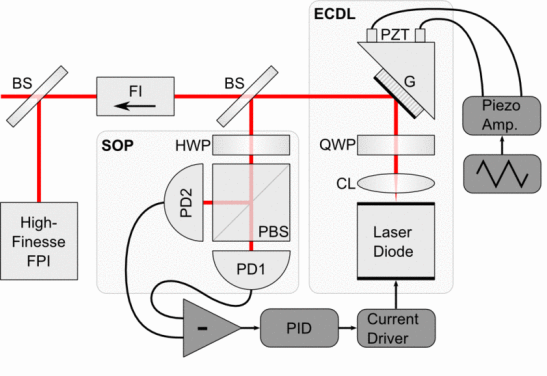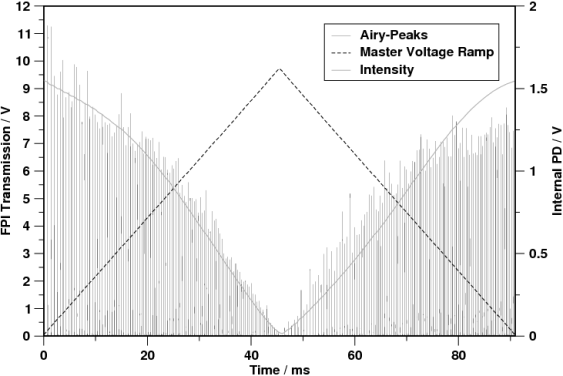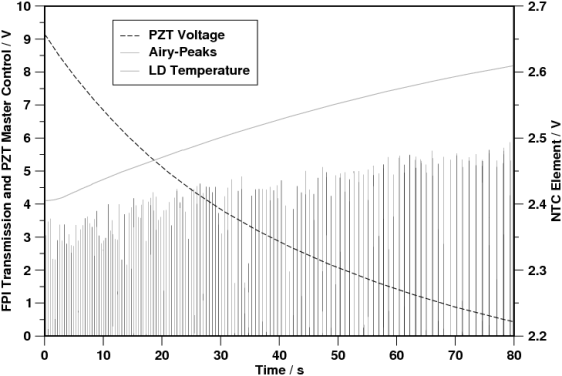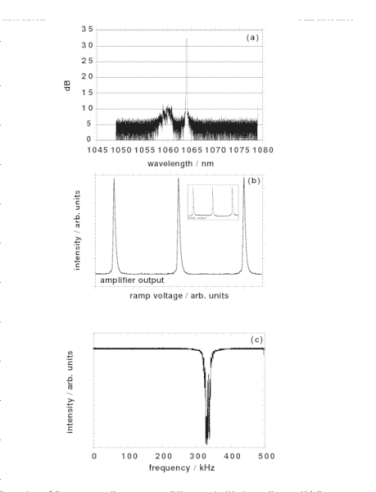Laser systems and wavelengths
| LWI | 254nm (FHG of ECDL 1015nm, 2 cavities LBO BBO) 405nm 436nm (ECDL 872nm SHG in cavity PPKTP) 546nm (ECDL 1092nm SHG cavity LiNbO3) |
| LIDAR | 1087nm DFB pulse SHG single pass to 543nm in KTP |
| SPARC | 515nm and 257nm pulse and cw LBO and BBO |
| MOT | 254nm (ECDL 1015nm, FHG LBO BBO) |
| Qhub | 1550nm |

General setup of the ECDL with polarization locking

Modehop free tuning over 105 GHz using Piezo-Current locking

Modehop free tuning over 130 GHz using Temperature-Piezo Locking
ECDL development
Polarization Locked Tuning of an ECDL
We demonstrated tuning laser employing a non-AR coated diode enabled mode-hop free tuning up to a tuning range of 130 GHz.
History
Practical tests of the NO sensor showed that the principle of the sensor works. However, due to the limitations in the scanning of the ECDL caused by the acoustically and vibrationally challenging environment, the sensitivity was limited. Therefore we concentrated on ways to extend the mode-hop free tuning range of ECDLs in general. Obviously such systems have a large number of possible applications.
References
- Thorsten Führer, Sabine Euler and Thomas Walther, Model for tuning an external-cavity diode laser by polarization locking, Opens external link in new windowJ Opt. Soc. Am. B 28 (2011) 508-514
- Thorsten Führer, Denise Stang and Thomas Walther, Actively controlled tuning of an external cavity diode laser by polarization spectroscopy, Opens external link in new windowOptics Express 17 (2009) 4991-4996
- Thorsten Führer and Thomas Walther, Extension of the mode-hop free tuning range of an External Cavity Diode Laser Based on a Model of the Mode-hop Dynamics, Optics Letter 33 (2008) 372-374
CW Nd-doped fiber amplifiers
We demonstrated amplifying the output of a MISER to several Watt power without increasing its line width.

Output power as a function of pump power. The output power was limited by the available pump power.

Spectra of the output of the fiber amplifier. (a) broadband spectrum (b) Spectrum of scanning Fabry-Perot interferometer (the inset shows the spectrum of the MISER) (c) Heterodyne beat note from output with second MISER
CW Yb-doped fiber amplifiers
We use Yb-doped fiber amplifier to generate high output powers at 1014.8nm and 1029nm for different applications. Recently we have demonstrated up to 30W of output power using a Yb-doped fiber amplifier, as can be seen in the graph.
Output power using Yb-doped fiber amplifier
Recently we have demonstrated up to 30W of output power using an Yb-doped fiber amplifier, as can be seen in the graph.
Pulsed Fiber Amplifier
A four stage Yb-doped fiber amplifier with Fourier-transform limited pulses in the ps-regime has been successfully implemented. Using photonic crystal fibers for the two last stages, output powers up to 57W can be achieved regardless of the pulse duration, as can be seen in the graph.
A three stage Yb-doped fiber amplifier exhibiting Fourier-transform limited pulses in the ns-regime has been demonstrated. The power was limited by the onset of stimulated Brillouin scattering. A careful optimization of fiber parameters was necessary in order to achieve the energy levels in question.


Peak power and energy per pulse as function of the pulse duration

Output energy of the third stage at the fundamental and after SHG
References
|
Let's assume we have a laser beam at a given wavelength impinging on a non-linear crystal. It is possible to observe a second laser beam coming out of the crystal with twice the frequency of the original laser beam, which then is the second harmonic. This effect comes from the nonlinear polarization of the crystal induced by the strong electric field of the laser beam. Also other nonlinear effects can occur such as sum frequency generation (SFG), difference frequency generation (DFG) and optical rectification (OR). The exact process depends on the type of non-linear crystal the geometry at which the crystal is cut polarization of the input beams. But two other conditions must be fulfilled: the conservation of energy and the conservation of momentum, which is called phase matching. The phases of the second harmonic wave must be in phase throughout the crystal such that the different parts interfere constructively at the end of the crystal and a macroscopic wave at the second harmonic emerges form the crystal. This phase matching condition can be fulfilled by the different refractive indices of a birefringent crystal.
CW Type-II Second Harmonic Generation without Temperature Control
Setup of the build-up cavity. By placing a lambda/2 plate inside the cavity, the cavity is only closed after the second round trip.
References
- Y. Emery, A. Fleischhauer, Th. Walther and E.S. Fry, Angle Tuned, type-II, external cavity frequency doubling without temperature stabilization, Appl. Opt. 38 (1999) 972
CW Type-I Second Harmonic Generation
We routinely frequency double and quadruple (via two consecutive SHG) the output radiation of our home built laser systems such as fiber amplified ECDL sources.
To achieve high conversion efficiencies and high output powers, we design enhancement cavities around the nonlinear crystals. Since many of our wavelengths of interest are deep in the ultraviolet spectral range, Beta Barium Borate (BBO) is the nonlinear medium of choice. Since BBO crystals are prone to degradation, the cavities are elliptically focusing enhancement cavities, reducing the effect of degradation while maintaining a high conversion efficiency. We recently demonstrated output powers of up to 18W at 515nm by employing LBO as the nonlinear medium. We were also able to demonstrate an output power of up to 2.45W at 257nm without degradation of the BBO crystal.
References
Jens Gumm, Denise Schwarz, Thomas Walther
High Power UV Lasers Employing Elliptically Focusing Enhancement Cavities
Review of Scientific Instruments, vol. 96, issue 3 (2025)
Daniel Preißler, Daniel Kiefer, Thorsten Führer, Thomas Walther
Evolutionary algorithm‐assisted design of a UV SHG cavity with elliptical focusing to avoid crystal degradation

Slope of the green power against the incident infrared light.

Slope of the UV power against the incident green light.
Pulsed SHG/THG/FHG
By a customized, very compact design of our frequency conversion unit we achieved high conversion efficiencies for second harmonic, third harmonic and fourth harmonic generation. Dual-wave plates (acting as lambda waveplates for the fundamental and lambda/2-plates for the harmonic) are placed in between non-linear crystals in order to use type-I processes in each step.
We recently showed SHG processes with conversion efficiencies up to 60% reaching an output power of up to 34W at 514nm with picosecond pulses. With that we were able to demonstrate output powers of up to 5.3W at 257nm by employing two BBO crystals.
References
- T. Beck, Master Thesis, Darmstadt, 2009
- C. Tian, Th. Walther, R. Nicolaescu, X.J. Pan, Y. Liao and E.S. Fry, Synchronous, dual-wavelength, injection-seeded amplification of 5 ns pulses in a flashlamp-pumped Ti:sapphire laser, Opt. Lett. 24 (1999) 1496-1498
- D. Depenheuer, J. Kohl-Landgraf, H. Gläßer, Th. Walther, A pulsed laser system with large spectral coverage by nonlinear frequency conversion, appeared Applied Physics B (2009)

Slope of the green power against the incident infrared light for different pulse durations.

Solpe of the UV power against the incident green light with different BBO setups.
We use different kind of software to calculate and operate our laser systems. Some of them are self written.
JLaserLab 2.0
JLaserLab is a platform independent GUI based resonator design software based on the ABCD matrix formalism. Development goals of JLaserLab are
- Ease of use
- Platform independence
- intuitive user interface
G-ray CAD 2.0
We therefore opted for a program (opens in new tab) with graphical user interface.
Feature List
- Easy Design of linear/ring resonators
- 3D-Engine for 3D representation of resonator
- ABCD matrix formalismn
- Real-time calculation of beam waist, cavity setup
- Stability analysis
- Easy adjust feature of elements
- Ray tracing of prism expanders etc.
Laser Diode Current Controller LQprO
Within our work on laser development we have developed a laser diode current controller. There are two versions:
- An ultra-low noise current controller (up to 140 mA)
- A low-noise current controller (up to 400 mA)
Feature List
- Low noise
- Stable operation
- Modulation capabilities
- Slow modulation over full scale
- Simultaneous slow/fast modulation
- Suitable for Pound-Drever-Hall stabilization
- Four layer board SMD technology
- Other currents/voltages upon request
- 19'' Rack assembly incl. power supply available
Data Sheet (opens in new tab)
Please contact Thorsten Führer for more details.











